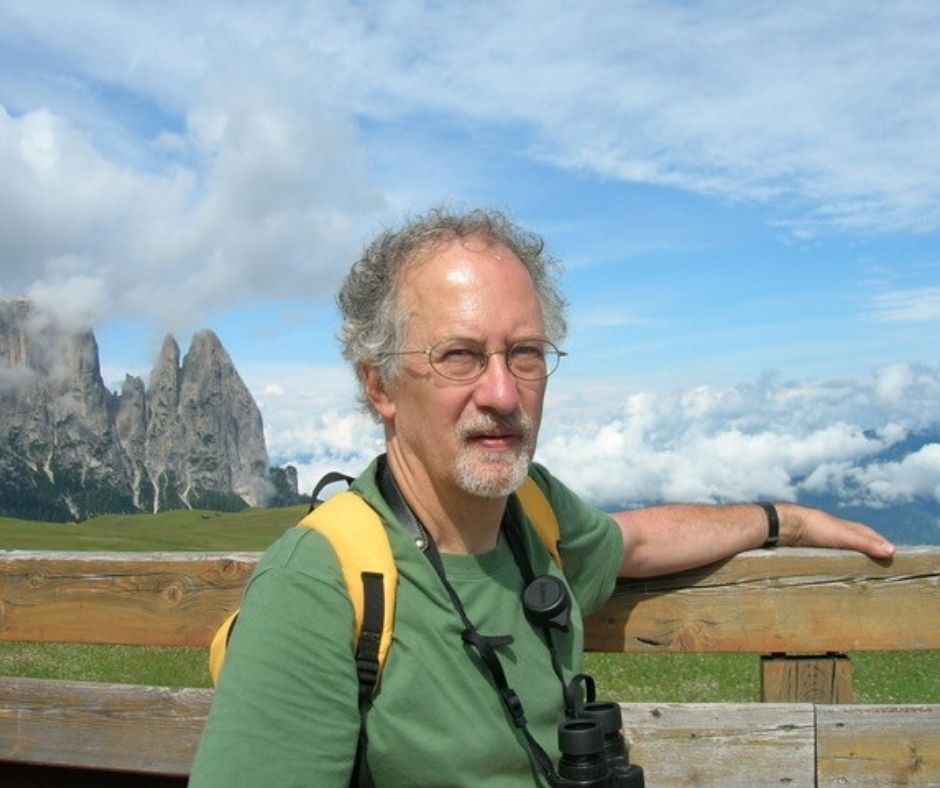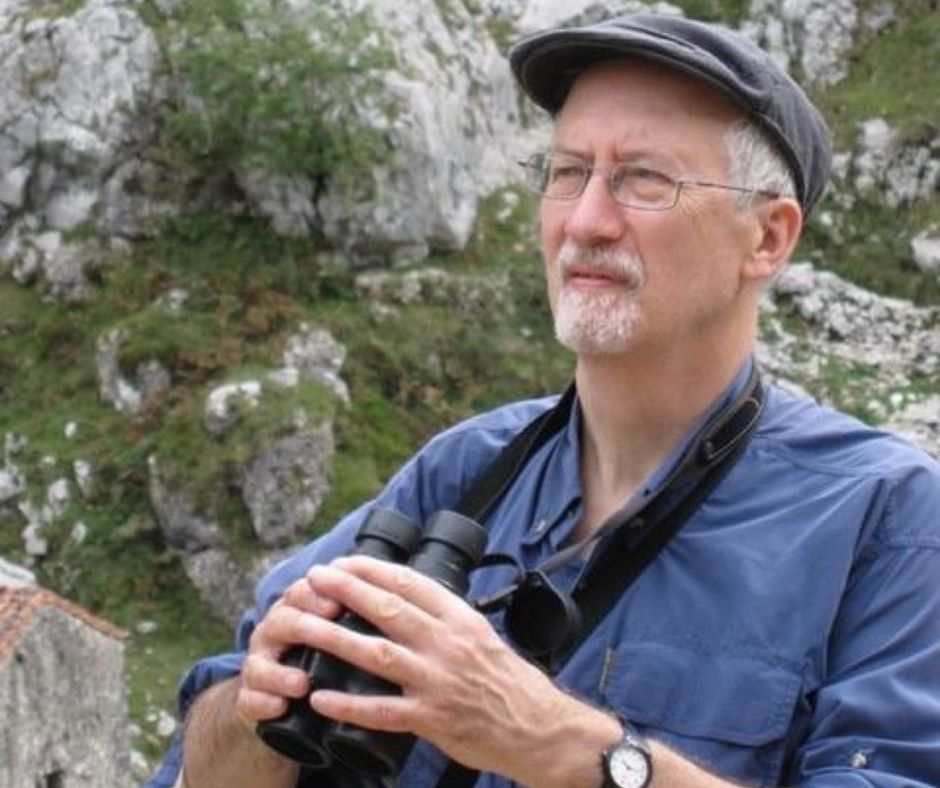If you’ve ever picked up a book about birds, it is quite likely that Jonathan Elphick wrote it or was one of the major contributors to it. A passionate naturalist from an early age, Jonathan completed his undergraduate studies at Swansea and soon afterwards set to work on a 51-year career as a wildlife writer, editor, consultant, lecturer and broadcaster, specialising in ornithology.
Jonathan has travelled extensively at home and abroad to study birds and other wildlife, and to promote conservation. He was elected as a Scientific Fellow of the Zoological Society of London in recognition of his services to the popularisation of zoology and in 2006 was elected a Fellow of the Linnean Society of London, the world’s oldest continuously active biological society since its foundation in 1788.
The many books he has written include an award-winning field guide to the birds of Britain and Ireland, The Birdwatchers’ Handbook (BBC Worldwide, 2001); The National Parks and other wild places of Britain & Ireland (New Holland, 2002), with photographs by renowned wildlife photographer David Tipling; with John Woodward, RSPB Pocket Birds (Dorling Kindersley, 2003 and subsequent editions); the highly acclaimed Birds: The Art of Ornithology, a study of ornithological art through the ages (Scriptum Editions, in association with the Natural History Museum, 2004, now in its fourth edition, NHM 2018); Great Birds of Europe (Duncan Baird, 2008), with his text celebrating 200 special birds of the region each accompanied by an images from David Tipling and other world-class bird photographers; the best seller Birdsong (Quadrille, 2012) a guide to the songs and calls of common British birds, which includes a built-in sound module.
Then followed several major titles he wrote for the Natural History Museum: the 608-page title The World of Birds, the first half a detailed account of bird biology, and the second a survey of every bird family in the world (2014); a revised edition of the first half of that book, Birds: A complete guide to their biology and behaviour, was published in 2016, while a complete revision of the second half, Bird Families of the World, appeared in April 2019. Jonathan is currently working on another book on bird art and a memoir of his early days growing up as a naturalist in North Wales, interweaving science, lyrical description of landscape, history and literature in a tale of memory, loss, and landscape. In 2016, he delivered the annual Condry memorial lecture in memory of one of Wales’ greatest 20th century naturalists, Bill Condry, choosing as his theme his study from an early age of the birds of North Wales.
Jonathan spent 15 years as Specialist Researcher working on Birds Britannica, by Mark Cocker (Chatto & Windus, 2005) and Birds & People, by Mark Cocker and David Tipling (Random House, 2013), respectively the largest surveys of cultural attitudes to birds in Britain & Ireland, and worldwide.
He served for six years on the steering group of New Networks for Nature, and is he is still very much involved with this important charity. It is a unique and broad alliance of individuals, from scientists and writers to visual artists and musicians, who work together to celebrate and defend nature as a crucial part of our identity and cultural heritage.
"In 1964, my application to study Zoology at Swansea University (then known as the University College of Swansea) was accepted. There was a focus on marine biology, which I found fascinating, but I also managed to spend time observing birds, both on university field trips and at weekends, from the then very small colonies of Guillemots, Kittiwakes and other more numerous seabirds around the Gower coastline, Reed Warblers at Oxwich marshes and large flocks of Oystercatchers and other waders to the small resident though non-breeding population of Eider at Burry Inlet, here farther south than any other regular occurring concentration of these attractive sea ducks. I was thrilled on a summer walk on heathland on the Gower to hear at dusk a Nightjar uttering its strange, mechanical sounding, rising and falling churring song, often likened to a distant motorbike, as the species had already become rare in the area."
"Above all, I owe a great debt of gratitude to all the teaching staff of the Zoology department..."
"Above all, I owe a great debt of gratitude to all the teaching staff of the Zoology department, as at times I was probably not a model student! I am especially thankful to Elis Wyn Knight-Jones, our remarkable Professor of Zoology (the first to hold this post when he organised the new Department of Zoology in December 1956. A pioneering diver and outstanding marine biologist, he was also, as so many of his former students have attested, not only an inspiring and charismatic educator, always conveying his passion for his subject, but also one of the most encouraging and kindly tutors I have ever met. His patience and empathy were to the fore during my first year, when I went through a difficult patch of depression, and had to take a year out. Recognising my natural interest in zoology, he made it so much easier for me to do this and return refreshed and renewed the following year. Everyone I have met whom he taught has stories about his inspirational and generous nature, his delightful sense of humour, and his sometime apparent lack of awareness of time; just two of my memories are of his starting a lecture and then saying he wasn’t supposed to be there and should have been at a meeting ten minutes beforehand, and on another occasion in answer to a question, saying with refreshing honesty 'I haven’t the foggiest idea, old boy.' ”
"I spent my first year living not in one of the new halls on campus but in the impressive setting of Neuadd Gilbertson, based in the Grade II listed building that is Clyne Castle and set in fine gardens with a view over the wide sweep of Swansea Bay. One of the reasons I relished my choice of university was the extensive and beautiful campus of Singleton Park, the fine coastline and the proximity to the glorious Gower Peninsula, which had become the first Area of Outstanding Natural Beauty in the UK eight years before I arrived."
"The following year, I lived for many months in a caravan out on the Gower, in Parkmill just across the road from Three Cliff Bay, one of Wales’ most beautiful beaches (along with the vast sweep of Rhossili, which I also visited often). A powerful memory still clear in my mind was of walking back there from an evening in the University bar and seeing a spectacular display of meteors streaking across the night sky."
"In 1965 I moved to a little house in Pleasant Street near the railway station, which I shared with others, including a fellow student at the university, John Makin, and John Howes and his partner Adrienne, who were at Swansea Art College; all remain to this day very good friends. Together with another university student, Dave Yoxall, who was a former sharer of the Pleasant Street house, we were involved in running the Adelphi Folk Club. My final year saw me living in another much larger house in Brynmill Crescent with several university students, including Dimitri Kontou, studying philosophy, who again remains an important friend, despite having moved to Canada soon after our graduation in 1968."
"I have many affectionate memories of the town as well as of the university..."
"I have many affectionate memories of the town as well as of the university: the general warmth of the people, the wonderful old market, where I could buy local specialities such as cockles, laver bread and welshcakes, the many and varied pubs where I probably spent too much of my grant money and meals in the curry restaurants that followed the pub or folk club visits – which made a change from my main diet during the week, based around a large portion of cheese or meat pasty, beans and chips, washed down with copious tea, in the Singleton Park refectory. Girlfriends, too, tended to be more from the town than the university. Rag week in my first year, riding on one of the floats parading the town, was also a memorable occasion, as it also included a bold and potentially foolhardy nocturnal climb up a wall of Cardiff Castle culminating in the unfurling of a banner proclaiming our presence to onlookers."
"Throughout my time at Swansea and for many years after, I was a regular performer as a singer of traditional songs, first at the University Folk Club, and then as one of those running the Adelphi Folk Club in the pub of that name in Wind Street, which meandered down to the docks and then had a reputation as a rather rough part of Swansea. Starting in autumn 1965, our folk club became known throughout Britain and Ireland as a great venue (in no small part due to the quality of the chorus singing from the audience) for guest performers, including the Young Tradition, Sandy Denny, Shirley Collins, John Renbourn, as well as blues performers including famous originals from the USA, such as the Reverend Gary Davis and Mississippi Fred MacDowell, and home grown blues exponents, notably Jo Ann Kelly and her brother Dave from London."
"I also love rock music, and of course the mid to late 1960s period when I was in Swansea was a great time to see so many of the bands I loved when they were becoming famous, including The Who, Manfred Mann, the Pretty Things (with my long hair I was mistaken for one of the members and got in to a gig at the Patti Pavilion free) and many others, including local bands such as The Jets, Martin Ace and The Aces; I also saw the Beatles in Cardiff, but couldn’t hear them due to the deafening screams from the massed ranks of teenage girls. I also spent a fair amount of my limited money at Snell’s Record Shop."
Read more about Jonathan’s life and how he became a naturalist.



